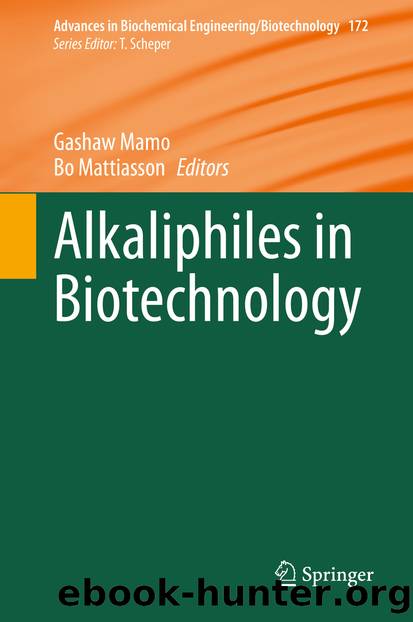Alkaliphiles in Biotechnology by Unknown

Author:Unknown
Language: eng
Format: epub
ISBN: 9783030497361
Publisher: Springer International Publishing
7 Carotenoids
Carotenoids constitute a structurally diverse group of colored lipidic pigments, which are widespread in nature and play crucial roles in many physiological processes. Carotenoids represent a long aliphatic polyene chain composed of “n” isoprene units (C5H8), which are sometimes terminated by rings, and may or may not have additional oxygen atom attached. They are initially synthesized with a chain of 30 or 40 carbon atoms from prenyl pyrophosphates, and they may be extended at a later stage up to 50 carbon atoms [57]. There are two general classes of carotenoids: carotenes and xanthophylls. The familiar carotenes are β-carotene and lycopene. Both are strict hydrocarbon carotenoids and do not possess any substituent (or even oxygen) in their structures. Xanthophylls or oxycarotenoids, which belong to the second group, are oxygen-containing molecules. Lutein and zeaxanthin are two xanthophylls with –OH groups in their structures, whereas canthaxanthin and echinenone contain =O groups. Astaxanthin has both –OH and =O groups in its structure [58].
Carotenoids have a wide range of application in the health care and nutraceutical industry; they are produced as food colorants, feed supplements, and nutraceuticals, for cosmetic and for pharmaceutical purposes. Carotenoids are essential for humans and must be supplied through diet. The growing importance of carotenoid has also led to an increase in the demand for carotenoids in the global market, which was estimated to be ~1.24 billion USD in 2016, and is projected to increase to ~1.53 billion USD by 2021, at a compound annual growth rate (CAGR) of 3.8% from 2016 to 2021 [58].
Carotenoids are essential components of all photosynthetic organisms due to their eminent photoprotective and antioxidant properties. However, their occurrence is not restricted to plants, algae, and cyanobacteria, as some fungi and non-photosynthetic bacteria can synthesize carotenoids as well [59]. Recently, microbial sources of carotenoids have received attention due to the stringent rules and regulations applied to chemically synthesized/purified pigments (like replacing synthetic astaxanthin for salmon feed). Microorganisms for the industrial production of carotenoids are preferred over other natural sources (such as vegetables and fruits) due to problems of seasonal and geographic variability in production of the latter [60].
According to the Carotenoids Database providing chemical information on 1,117 natural carotenoids with 683 source organisms, carotenoids seem to have been spread largely in bacteria, as they produce C30, C40, C45, and C50 carotenoids (based on the molecular carbon number), with the widest range of end groups, and they share a small portion of C40 carotenoids with eukaryotes. Archaea share an even smaller portion with eukaryotes. Eukaryotes have evolved a considerable variety of C40 carotenoids. Considering carotenoids, eukaryotes seem more closely related to bacteria than to archaea [61].
Carotenoids of diverse structures have been also found among alkaliphilic bacteria. Previous reviewers have reported about triterpenoid carotenoids from yellow pigmented alkaliphilic Bacillus sp. [1]. A lycopene type of carotenoid pigment was produced by alkaliphilic Microbacterium arborescens AGSB, obtained from coastal sand dunes. Novel carotenoid glucoside esters have been reported from alkaliphilic Heliobacteria [62]. Later, the same type of carotenoid, OH-diaponeurosporene glucosyl esters, was found in two other novel taxa of Heliobacteria, Heliorestis acidaminivorans sp.
Download
This site does not store any files on its server. We only index and link to content provided by other sites. Please contact the content providers to delete copyright contents if any and email us, we'll remove relevant links or contents immediately.
| Automotive | Engineering |
| Transportation |
Whiskies Galore by Ian Buxton(41879)
Introduction to Aircraft Design (Cambridge Aerospace Series) by John P. Fielding(33064)
Small Unmanned Fixed-wing Aircraft Design by Andrew J. Keane Andras Sobester James P. Scanlan & András Sóbester & James P. Scanlan(32743)
Craft Beer for the Homebrewer by Michael Agnew(18140)
Turbulence by E. J. Noyes(7936)
The Complete Stick Figure Physics Tutorials by Allen Sarah(7307)
Kaplan MCAT General Chemistry Review by Kaplan(6867)
The Thirst by Nesbo Jo(6828)
Bad Blood by John Carreyrou(6552)
Modelling of Convective Heat and Mass Transfer in Rotating Flows by Igor V. Shevchuk(6391)
Learning SQL by Alan Beaulieu(6211)
Weapons of Math Destruction by Cathy O'Neil(6146)
Man-made Catastrophes and Risk Information Concealment by Dmitry Chernov & Didier Sornette(5921)
Digital Minimalism by Cal Newport;(5664)
Life 3.0: Being Human in the Age of Artificial Intelligence by Tegmark Max(5474)
iGen by Jean M. Twenge(5366)
Secrets of Antigravity Propulsion: Tesla, UFOs, and Classified Aerospace Technology by Ph.D. Paul A. Laviolette(5309)
Design of Trajectory Optimization Approach for Space Maneuver Vehicle Skip Entry Problems by Runqi Chai & Al Savvaris & Antonios Tsourdos & Senchun Chai(5011)
Pale Blue Dot by Carl Sagan(4912)
